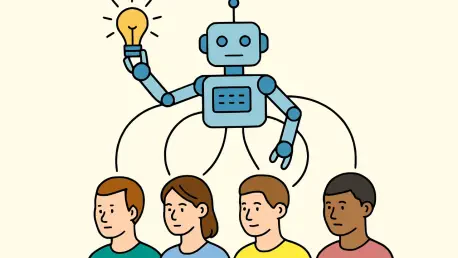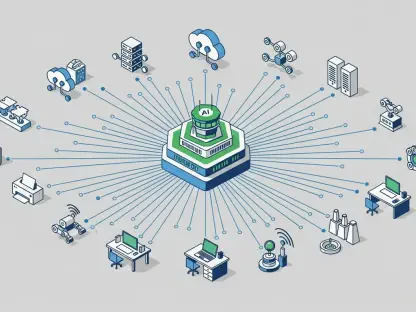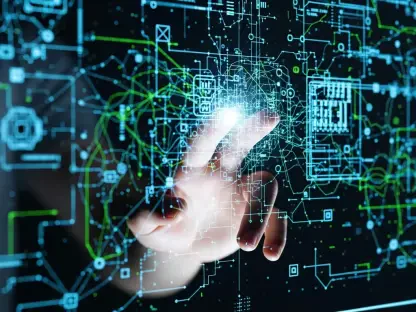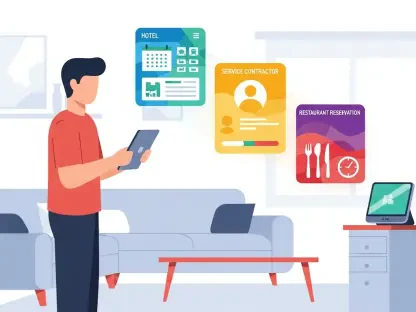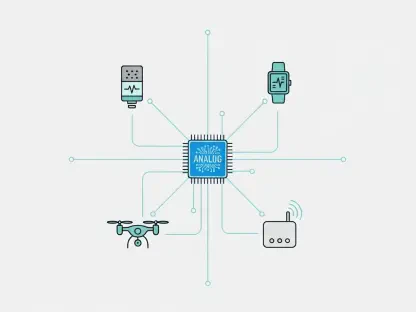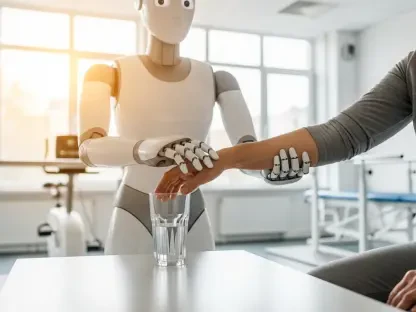Imagine a world where a tireless assistant helps brainstorm a novel’s plot twists at midnight or designs a captivating book cover in mere minutes, all without needing a degree in graphic arts. Artificial Intelligence (AI) is turning this vision into reality for countless authors and illustrators, reshaping the creative landscape with tools that promise to streamline workflows and spark inspiration. Far from being a distant dream, AI is already embedding itself into the daily routines of creators, offering solutions to age-old challenges like writer’s block and design limitations. This technology isn’t just about automating tasks; it’s about enhancing the human capacity to imagine and create.
The allure of AI lies in its ability to act as a collaborative ally, supporting rather than supplanting the unique spark of human originality. From drafting compelling narratives to crafting professional visuals, these tools are breaking down barriers, making high-quality creative output more accessible than ever. However, a critical question remains: can a machine truly grasp the subtleties of emotion and personal vision that define art? While AI may not replicate the depth of human experience, its role as a supportive partner is undeniable, providing practical assistance and freeing up mental space for deeper artistic exploration.
AI in Writing: A Supportive Co-Writer
Brainstorming and Drafting
AI tools are transforming the way stories are born, acting as an ever-ready brainstorming companion for writers facing the daunting blank page. These platforms can generate plot ideas, suggest character arcs, or even draft entire scenes based on minimal input, helping authors navigate creative ruts with surprising ease. For those juggling multiple projects or tight deadlines, this kind of assistance can be invaluable, offering a starting point that might otherwise take hours to conceive. The technology doesn’t aim to write the story alone but rather to ignite inspiration, allowing the creator to build upon a foundation of machine-generated ideas. This dynamic shifts the early stages of writing from a solitary struggle to a more collaborative effort, where AI serves as a springboard for human imagination to take flight.
Beyond initial ideas, AI’s drafting capabilities extend to fleshing out narratives with coherent structure and detail, often adapting to the writer’s specific style or genre preferences. Some tools allow users to input a few sentences or a rough outline, then expand those fragments into full paragraphs or chapters, saving significant time in the creative process. This functionality proves especially useful for indie authors who lack the resources for extensive writing workshops or co-authors. However, the output still requires a human touch to ensure it resonates with authenticity and personal voice. By using AI as a drafting partner, writers can focus more on refining their unique storytelling elements rather than getting bogged down in the mechanics of first drafts.
Editing and Polishing
When it comes to refining a manuscript, AI steps in as a meticulous editor, capable of spotting grammatical errors, awkward phrasing, and stylistic inconsistencies with precision. These tools go beyond basic spell-check, offering suggestions to tighten prose or enhance readability, which can be a lifeline for writers who struggle with self-editing. For instance, a complex novel draft can be analyzed in minutes, with feedback provided on sentence structure and clarity, tasks that might otherwise consume hours of manual review. This efficiency allows creators to maintain momentum in their work, ensuring that technical hiccups don’t derail the creative flow. The result is a polished piece that feels professional without the need for an expensive human editor.
Additionally, AI editing tools often provide insights into tone and pacing, helping authors align their writing with the intended emotional impact or audience expectations. This deeper level of analysis can highlight areas where a story feels rushed or overly dense, offering actionable recommendations to balance the narrative. While such features are incredibly helpful, they cannot fully grasp the nuanced intent behind every word or scene, necessitating a creator’s oversight to preserve the story’s heart. By integrating AI’s technical prowess with human judgment, writers can achieve a refined manuscript that retains its unique essence, demonstrating how technology can elevate rather than dictate the editing process.
AI in Design: Visual Creativity Made Easy
Crafting Professional Visuals
For authors and illustrators without formal training in graphic arts, AI design tools are nothing short of revolutionary, enabling the creation of stunning visuals with minimal expertise. Book covers, illustrations, and other design elements that once required hiring a professional artist can now be produced using intuitive platforms that guide users through the process. These tools often come equipped with templates and customization options, allowing even novices to craft visuals that rival professionally commissioned work. This accessibility empowers indie creators to present their projects with a polished aesthetic, enhancing their marketability without breaking the bank. AI’s role here is to democratize design, ensuring that a lack of artistic skill doesn’t hinder a project’s potential impact.
Moreover, the speed at which AI can generate high-quality visuals is a significant advantage for creators under time constraints, such as those preparing for a book launch or crowdfunding campaign. A striking cover or promotional graphic can be conceptualized and finalized in a fraction of the time it would take manually, meeting tight schedules without sacrificing quality. These tools often adapt to specific inputs, like genre or mood, ensuring the output aligns with the project’s vision. Still, human input remains essential to tweak the final design, adding personal touches that reflect the creator’s intent. This synergy between AI efficiency and human oversight results in visuals that stand out while maintaining an authentic connection to the underlying work.
Marketing and Branding Assets
AI also excels in helping creators build a cohesive brand through marketing materials, offering solutions for everything from promotional posters to custom logos. These tools simplify the process of creating eye-catching assets that resonate with target audiences, a critical factor for authors and artists seeking to establish a recognizable presence. With minimal input, AI can generate unique designs tailored to specific campaigns or themes, ensuring consistency across various platforms. This capability is particularly beneficial for self-published authors who must handle their own marketing, as it reduces the need to outsource expensive design services. The technology acts as a virtual branding assistant, streamlining a process that can otherwise be overwhelming.
Furthermore, the customization offered by AI in branding extends to generating niche or unconventional assets, such as stylized caricatures or thematic graphics that capture a project’s essence. This level of personalization helps creators differentiate themselves in crowded markets, where standing out is often the key to success. While the output can be impressively tailored, it’s crucial for artists to review and adjust these materials to ensure they align with their personal or project-specific identity. Relying solely on AI risks producing generic content that lacks soul, so a balance must be struck. By leveraging AI’s knack for quick, customized design while infusing human creativity, creators can build a brand that feels both professional and deeply personal.
Benefits of AI as a Creative Partner
Efficiency and Time-Saving
One of the most compelling advantages of AI in creative fields is its ability to drastically reduce the time spent on repetitive or labor-intensive tasks. Whether editing a lengthy manuscript or designing a series of promotional images, AI can complete these processes in minutes rather than hours, which is a boon for creators managing multiple responsibilities. This efficiency doesn’t just save time; it preserves mental energy, allowing authors and designers to channel their focus into the more imaginative aspects of their craft. For instance, instead of laboring over grammar corrections, a writer can dive deeper into character development. AI’s speed transforms the creative workflow into a more fluid, less draining experience, amplifying productivity without compromising quality.
Equally important is how this time-saving aspect enables creators to meet demanding schedules, such as publishing deadlines or marketing rollouts, with greater ease. AI tools can handle last-minute adjustments or bulk content creation, ensuring projects stay on track even under pressure. This reliability is especially critical for independent creators who often lack the support of large teams. However, while the speed is a clear benefit, it’s vital to allocate time for reviewing AI-generated content to maintain originality and intent. By blending AI’s rapid execution with thoughtful human input, creators can achieve a streamlined process that maximizes both efficiency and artistic integrity, redefining how quickly high-quality work can be produced.
Accessibility for All Creators
AI tools are breaking down financial and skill barriers, making professional-grade creative resources available to a broader audience than ever before. Many of these platforms are either free or offered at a low cost, providing an affordable alternative to hiring editors, designers, or marketing experts. This affordability is a game-changer for self-published authors and independent artists who often operate on tight budgets, allowing them to produce polished work without significant investment. The intuitive interfaces of these tools further enhance accessibility, ensuring that even those with minimal technical or artistic know-how can achieve impressive results. AI levels the playing field, empowering creators from diverse backgrounds to compete in professional arenas.
Beyond cost and ease of use, the sheer variety of AI tools available means that creators can find solutions tailored to their specific needs, whether they are writing a novel or designing a logo. This inclusivity extends to individuals who may have previously felt excluded from creative industries due to a lack of training or resources. For example, an aspiring author with no design experience can now create a visually appealing book cover independently. While this democratization is transformative, it also underscores the need for discernment in selecting tools that align with personal goals. Embracing AI’s accessibility while maintaining a critical eye ensures that creators can harness its benefits to produce work that reflects their vision and resonates with their audience.
Challenges and Cautions with AI Collaboration
Maintaining Creative Control
While AI offers substantial support in writing and design, a significant challenge lies in preserving the creator’s unique voice amidst algorithmic suggestions. Over-reliance on these tools can lead to outputs that feel formulaic or disconnected from the artist’s original intent, as AI often prioritizes patterns over individuality. For instance, a story generated with heavy AI input might lack the personal quirks or cultural nuances that define a writer’s style. Creators must remain vigilant, using AI as a starting point or enhancer rather than the final word, ensuring that their work retains its distinct identity. This balance is essential to prevent technology from overshadowing the human essence that lies at the heart of any creative endeavor.
Additionally, maintaining creative control requires a proactive approach to customizing and filtering AI outputs to align with personal vision, ensuring that the technology serves the creator’s unique style and intent. Many tools allow for adjustments, but without careful oversight, the results can veer into generic territory, diminishing the work’s originality. Creators should view AI as a brainstorming partner or technical assistant, not a decision-maker, and dedicate time to refining its contributions. This process might involve rewriting AI-generated text or tweaking designs to infuse them with personal touches. By asserting control over the creative process, artists and authors can leverage AI’s capabilities while safeguarding their authenticity, ensuring the final product is a true reflection of their imagination rather than a machine’s interpretation.
Limitations of Emotional Depth
AI’s ability to mimic styles and structures in writing and design is impressive, yet it often falls short when it comes to capturing the profound emotional depth inherent in human experience. A machine can suggest a poignant scene or a visually striking image, but it lacks the lived context and empathy that fuel authentic emotional resonance in art. For example, a story crafted with AI assistance might follow a logical arc but miss the subtle pain or joy that a human writer draws from personal memory. This limitation means that creators must infuse their work with the emotional nuances that only they can provide, using AI as a framework rather than the soul of their creation.
Moreover, this gap in emotional understanding can affect how audiences connect with AI-influenced content, as the absence of genuine feeling may leave a piece feeling hollow despite technical perfection. Creators need to prioritize adding layers of personal insight and passion to their projects, ensuring that the heart of their message shines through. While AI can handle the mechanics of storytelling or design, it’s the human touch that transforms a piece into something truly memorable. Recognizing this boundary allows artists to use AI for its strengths—efficiency and ideation—while dedicating their energy to weaving emotional threads that resonate deeply, creating work that feels alive and uniquely human.
The Future of AI in Creativity
Evolving Capabilities
As AI technology continues to advance, its role in creative industries is poised for remarkable expansion, promising tools with even greater sophistication and nuance. Future developments might include platforms that better understand context in storytelling, generating narratives that feel more aligned with a writer’s emotional tone or cultural background. In design, AI could evolve to offer hyper-detailed customization, producing visuals that mimic specific artistic movements with uncanny accuracy. These advancements could redefine creative workflows over the coming years, providing authors and illustrators with assistants that are increasingly intuitive. Such progress suggests a landscape where technology becomes an even closer ally, tackling complex creative challenges with precision.
Equally exciting is the potential for AI to integrate more seamlessly with other emerging technologies, enhancing its utility in ways yet unimagined. Imagine tools that combine voice recognition with writing assistance to transcribe and refine spoken ideas in real time, or design platforms that adapt to virtual reality for immersive creation experiences. While these possibilities are on the horizon, they also highlight the need for creators to stay informed about evolving tools and their implications. Keeping pace with AI’s growth ensures that artists can harness its expanding capabilities to push boundaries, crafting work that reflects both technological innovation and timeless human expression. This forward momentum signals a future rich with creative potential.
Balancing Technology and Artistry
Looking ahead, the key to a successful partnership with AI in creative fields lies in striking a delicate balance between leveraging technology and preserving artistic integrity, ensuring that innovation enhances rather than overshadows the human touch. As tools become more powerful, there’s a risk of becoming overly dependent on their suggestions, potentially diluting the raw, personal essence that defines great art. Creators must approach AI as an enhancer, using it to handle mundane tasks or spark initial ideas while ensuring that the core vision remains distinctly human. This balance will be crucial in maintaining authenticity in an era where technology can easily dominate the creative process. Emphasizing artistry over automation ensures that the soul of creation isn’t lost to efficiency.
Furthermore, fostering this equilibrium involves cultivating a mindset of curiosity and critical engagement with AI tools, viewing them as partners rather than replacements for human effort. Creators should experiment with these technologies, testing their limits and adapting their outputs to suit personal styles, while always prioritizing the emotional and cultural depth only they can provide. As AI continues to shape the creative landscape, this balanced approach will empower artists to redefine what’s possible, blending cutting-edge tools with the irreplaceable value of human perspective. Reflecting on past integrations of technology, it’s evident that thoughtful collaboration has yielded groundbreaking results, setting a hopeful precedent for future artistic endeavors.
